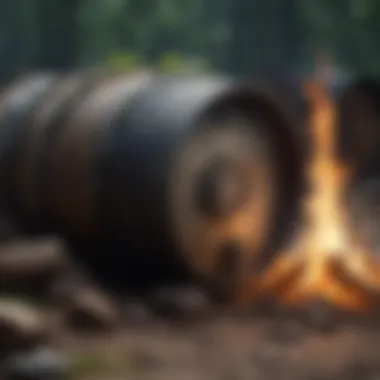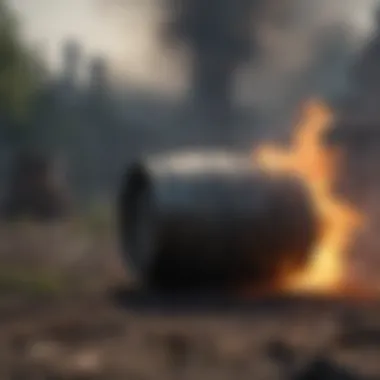Unveiling the Environmental Impact of Burning Yard Waste in a Barrel


Overview of the Topic
Burning yard waste in a barrel is a common practice in many households and communities, aiming to dispose of organic waste efficiently. This method involves collecting yard debris such as branches, leaves, and grass clippings and burning them in a metal barrel. While seemingly convenient, this practice can have detrimental effects on the environment, contributing to air pollution and releasing harmful chemicals into the atmosphere.
Current Scenario and Challenges
Currently, the act of burning yard waste in a barrel poses several environmental challenges. The combustion of organic matter releases pollutants like carbon monoxide, particulate matter, and volatile organic compounds into the air. These emissions can degrade air quality, pose health risks to humans and wildlife, and contribute to global warming. Additionally, the combustion process is often incomplete, leading to the release of toxic compounds such as dioxins and furans, further exacerbating environmental harm.
Sustainable Alternatives
Exploring sustainable alternatives to burning yard waste is crucial for mitigating environmental impact. Composting, for instance, offers a more environmentally friendly method of managing organic waste. By composting yard debris, nutrients are returned to the soil, enhancing soil health and promoting plant growth. Furthermore, recycling yard waste into mulch or biomass can help reduce greenhouse gas emissions and support circular economy principles.
Implications and Significance
The impact of burning yard waste in a barrel extends beyond immediate environmental concerns. It underscores the urgent need for adopting sustainable waste management practices to safeguard ecosystems, protect public health, and preserve natural resources for future generations. By understanding the implications of this practice and embracing alternative solutions, we can collectively work towards a healthier, more sustainable environment.
Introduction
Burning yard waste in a barrel is a contentious practice with significant environmental implications that cannot be overlooked in today's era of heightened ecological awareness. As we delve into the intricacies of this process, we uncover a Pandora's box of potential risks and consequences on our surrounding ecosystems. Understanding the intricacies of burning yard waste in a barrel is essential to grasp the gravity of its impact on the environment, paving the way for informed decision-making and sustainable waste management practices.
Understanding Yard Waste
Definition of Yard Waste
Yard waste encompasses a myriad of organic materials generated from routine lawn and garden maintenance, including grass clippings, leaves, branches, and other plant debris. This rich tapestry of biodegradable material not only presents an opportunity for valuable recycling but also poses challenges in handling and disposal due to its bulk and seasonal abundance. The definition of yard waste lies at the heart of this article, shedding light on its crucial role in the discourse surrounding environmentally conscious waste management practices.
Common Types of Yard Waste
Common types of yard waste vary widely, ranging from freshly cut grass to fallen leaves and pruned branches. Each type brings its unique characteristics to the table, influencing the composting and recycling processes significantly. Understanding the common types of yard waste is essential to appreciate the diverse nature of materials involved in the burning process and their respective impacts on the environment.
Overview of Burning Yard Waste
Process of Burning in a Barrel
The process of burning yard waste in a barrel involves the combustion of organic materials within a confined space, typically a metal drum or container. This method, although commonly practiced by some, raises concerns due to incomplete combustion leading to the release of harmful emissions. Examining the process in detail allows us to dissect its mechanics and shed light on the environmental risks associated with this mode of waste disposal.
Reasons for Choosing this Method


The reasons behind selecting burning in a barrel as a method for yard waste disposal are often rooted in convenience and tradition. The ease of containment and simplicity of execution make this method appealing to many, despite its detrimental effects on the environment. Exploring the motivations driving this choice unveils a complex interplay of practicality, habits, and the need for more sustainable alternatives in our approach to yard waste management.
Environmental Impact
Air Pollution
Emission of Harmful Gases
The emission of harmful gases during the burning of yard waste is a significant concern for environmental health. Gases like carbon monoxide, nitrogen oxides, and volatile organic compounds contribute to air pollution, posing risks to human health and the atmosphere. Understanding the composition and effects of these emissions is crucial in mitigating their impact on the environment. While burning waste may seem expedient, the release of such gases can have long-lasting detrimental effects on local air quality and global climate stability.
Effects on Air Quality
The combustion of yard waste directly influences air quality by releasing particulate matter and toxins into the atmosphere. These pollutants can lead to respiratory issues, smog formation, and a decrease in air clarity. Monitoring the quality of the air is fundamental to safeguarding public health and environmental balance. Recognizing the effects of burning waste on air quality underscores the importance of adopting cleaner, more sustainable practices to minimize pollution and preserve the purity of the air we breathe.
Soil Degradation
Contamination of Soil
Contaminating the soil through burning yard waste impacts its essential properties, disrupting nutrient cycles and microbial biodiversity. The accumulation of ash and pollutants alters soil pH levels, leading to degradation and reduced fertility. The contamination of soil not only affects plant growth but also compromises the health of ecosystems dependent on soil for nourishment and stability. Protecting soil integrity is vital for sustaining agricultural productivity and biodiversity conservation.
Impact on Plant Growth
The detrimental impact of burning yard waste on plant growth manifests through soil degradation and the introduction of toxins into the environment. Plants rely on healthy soil for nutrients and water uptake, factors that can be compromised by contaminated soils. Moreover, exposure to airborne pollutants can hinder photosynthesis and overall growth, posing a threat to vegetation and ecosystem resilience. Addressing the repercussions of burning waste on plant growth emphasizes the need for eco-friendly waste management alternatives to support thriving plant communities.
Water Pollution
Runoff Contamination
Runoff contamination resulting from burning yard waste contributes to water pollution, affecting aquatic habitats and human water sources. Hazardous substances carried by runoff can leach into groundwater reservoirs, contaminating drinking water and jeopardizing aquatic biodiversity. Preventing runoff contamination necessitates responsible waste disposal methods that prevent pollutants from reaching water bodies. Mitigating the impact of burning waste on water quality is essential for preserving freshwater ecosystems and ensuring safe access to clean water.
Effects on Water Sources
The effects of burning yard waste on water sources encompass a spectrum of challenges, from chemical pollution to habitat degradation. Contaminants from burnt waste can seep into rivers, lakes, and streams, altering water chemistry and threatening aquatic life. Safeguarding water sources from the adverse effects of waste incineration requires proactive measures to minimize pollution and safeguard aquatic ecosystems. Recognizing the interconnectedness of land and water environments underscores the urgency of adopting sustainable waste management practices to protect our vital water resources.
Health Concerns
Yard waste burning in a barrel has significant health implications that must not be overlooked. Understanding these health concerns is vital to grasp the severity of the environmental impact caused by this practice. Respiratory issues and skin irritation are among the prominent health risks associated with burning yard waste.


Respiratory Issues
Inhaling toxic fumes during the burning process poses a major health threat to individuals in proximity. The inhalation of harmful gases released during yard waste combustion can lead to various respiratory ailments and long-term health complications. The exposure to these noxious fumes can significantly deteriorate air quality, posing risks to both humans and the ecosystem. Despite the convenience of burning yard waste in a barrel, the dangers of inhaling toxic fumes cannot be understated.
Health Risks Associated
The health risks associated with burning yard waste extend beyond respiratory issues. Individuals exposed to the smoke and ashes produced during burning can experience a range of health problems. These risks include allergic reactions, skin irritations, and potential long-term health consequences. Proximity to burning waste can lead to direct contact with ash particles, triggering allergic responses and skin sensitivity. Recognizing and addressing the health risks associated with burning yard waste is crucial for promoting public health and environmental well-being.
Skin Irritation
Skin irritation resulting from contact with ash particles is a common health concern related to burning yard waste in a barrel. The ashes produced during combustion contain various harmful substances that can cause skin reactions upon contact. Individuals who come into direct contact with ash particles may experience itchiness, redness, or other allergic responses. Moreover, allergic reactions triggered by these ash particles can exacerbate existing skin conditions, leading to discomfort and potential health complications.
Contact with Ash Particles
Contact with ash particles carries the risk of skin sensitivity and irritation. The abrasive nature of ash particles, combined with their chemical composition, can cause damage to the skin upon contact. Skin exposed to these particles may suffer from dryness, irritation, or allergic reactions, highlighting the importance of avoiding direct contact with ashes during or after burning yard waste.
Allergic Reactions
Individuals prone to allergies are particularly vulnerable to experiencing allergic reactions when exposed to ash particles. The unique composition of ash, including potential allergens and irritants, can trigger allergic responses in sensitive individuals. Symptoms of allergic reactions may range from mild irritation to severe skin inflammation, underscoring the importance of taking precautions to prevent skin exposure to ash particles.
Legal Regulations
Legal regulations play a crucial role in governing the practice of burning yard waste in a barrel. These regulations are essential for ensuring environmental protection and public health. By imposing rules and restrictions on such activities, legal regulations help minimize the negative impact of burning yard waste on the environment. They also serve to hold individuals and businesses accountable for their waste disposal practices, promoting responsibility and sustainability.
Local Restrictions
Laws Prohibiting Open Burning
Laws prohibiting open burning are instrumental in controlling the harmful effects of burning yard waste. These laws typically prohibit the open burning of waste materials due to the significant air pollution and health hazards it can cause. By outlawing this practice, authorities aim to protect air quality and reduce emissions of harmful pollutants into the atmosphere. The prohibition of open burning encourages individuals to seek alternative methods of waste disposal that are less detrimental to the environment.
Permits for Controlled Burns
Permits for controlled burns establish a framework for conducting controlled burning activities in a regulated manner. These permits are issued by relevant authorities after assessing factors such as weather conditions, air quality, and the type of materials to be burned. By obtaining a permit for controlled burns, individuals or organizations can responsibly manage yard waste disposal while adhering to strict guidelines to prevent environmental damage. Controlled burns help minimize risks associated with uncontrolled fires and enable authorities to monitor and enforce safe burning practices, ensuring minimal ecological impact.
Environmental Policies
Government Guidelines


Government guidelines provide a set of directives and recommendations for handling yard waste and biomass combustion. These guidelines outline best practices for waste management and burning processes to mitigate environmental harm. By following government guidelines, individuals can ensure that their waste burning activities are conducted in an eco-friendly and sustainable manner. The adherence to these guidelines helps reduce the release of harmful emissions and contaminants into the air, soil, and water, promoting overall environmental conservation.
Penalties for Violations
Penalties for violations serve as a deterrent against non-compliance with environmental regulations related to burning yard waste. These penalties may include fines, warnings, or legal consequences for individuals or entities found guilty of violating established guidelines. By imposing penalties for violations, authorities reinforce the importance of adherence to environmental policies and encourage responsible waste management practices. The threat of penalties acts as a motivator for ensuring legal compliance and serves as a protective measure to safeguard environmental integrity and public health.
Sustainable Alternatives
In this segment, the focus shifts towards sustainable alternatives to burning yard waste in a barrel. The necessity of exploring these alternatives lies in the detrimental impact of such practices on the environment. By delving into sustainable options, individuals can contribute positively to waste management while safeguarding ecological balance. Examining composting and mulching as viable alternatives underscores the importance of making informed choices for environmental sustainability.
Composting
Benefits of Composting:
Exploring the benefits of composting reveals a myriad of advantages for both the environment and individuals. Composting facilitates the decomposition of organic waste, transforming it into nutrient-rich soil amendments. This process not only reduces landfill waste but also fosters healthier soil suitable for plant growth. The efficiency of composting in converting food scraps and yard waste into valuable soil additives highlights its efficacy as a sustainable waste management approach.
Creating Nutrient-Rich Soil:
Creating nutrient-rich soil through composting is a fundamental aspect of sustainable agriculture. Compost, enriched with essential nutrients, improves soil structure, enhances water retention, and promotes beneficial microbial activity. The ability of nutrient-rich soil to support robust plant growth underscores its significance in sustainable farming practices. While composting requires time and effort, the long-term benefits of nutrient-rich soil make it a worthwhile investment in promoting environmental health.
Mulching
Preserving Soil Moisture:
The practice of mulching plays a critical role in preserving soil moisture, especially in arid regions. By covering the soil with organic materials like wood chips or straw, mulching helps reduce water evaporation, regulates soil temperature, and suppresses weed growth. The moisture-retention properties of mulch contribute to the sustainability of plant ecosystems, ensuring adequate hydration for plant roots and enhancing soil fertility. Incorporating mulching practices in gardening and landscaping proves advantageous in conserving water resources and promoting soil health.
Suppressing Weed Growth:
Mulching serves as an effective method for suppressing weed growth, limiting the competition between unwanted plants and desired vegetation. The practice of layering mulch impedes weed germination, blocks sunlight access to weed seeds, and mitigates weed establishment. Additionally, organic mulch gradually breaks down, enriching the soil with nutrients and fostering a favorable environment for desired plant species. The weed-suppressing properties of mulching offer a sustainable solution to reducing chemical herbicide use and maintaining visually appealing landscapes.
Conclusion
Burning yard waste in a barrel can have severe implications on the environment, impacting air quality, soil health, and water sources. As highlighted throughout this article, proper waste management is crucial for mitigating these negative effects. By promoting sustainable alternatives such as composting and mulching, individuals can significantly reduce the environmental harm caused by burning yard waste. It is imperative that communities prioritize environmental awareness and adopt eco-friendly practices to preserve the planet for future generations.
Promoting Environmental Awareness
Educating Communities
Educating communities plays a vital role in fostering environmental consciousness. By imparting knowledge about the detrimental effects of burning yard waste and the benefits of sustainable practices, communities can make informed decisions that contribute to a healthier environment. The key characteristic of educating communities lies in its ability to empower individuals to take concrete actions towards preserving nature. This approach is popular for its tangible impact in creating a more environmentally conscious society. However, the challenge lies in ensuring widespread participation and adherence to eco-friendly guidelines. Educating communities uniquely positions individuals to become stewards of the environment, but effective implementation and continuous engagement are essential for sustained success.
Encouraging Sustainable Practices
Encouraging sustainable practices is paramount in mitigating the environmental consequences of burning yard waste. By promoting environmentally friendly alternatives like composting and mulching, individuals can minimize their carbon footprint and contribute to a greener world. The key characteristic of encouraging sustainable practices is its focus on practical solutions that offer long-term benefits. This approach is beneficial for its positive impact on environmental health and resource conservation. However, the challenge lies in fostering widespread adoption of sustainable habits and overcoming inertia towards change. Encouraging sustainable practices distinguishes itself through its proactive stance on environmental conservation, but continuous support and education are necessary to instill lasting habits and promote a culture of sustainability.

